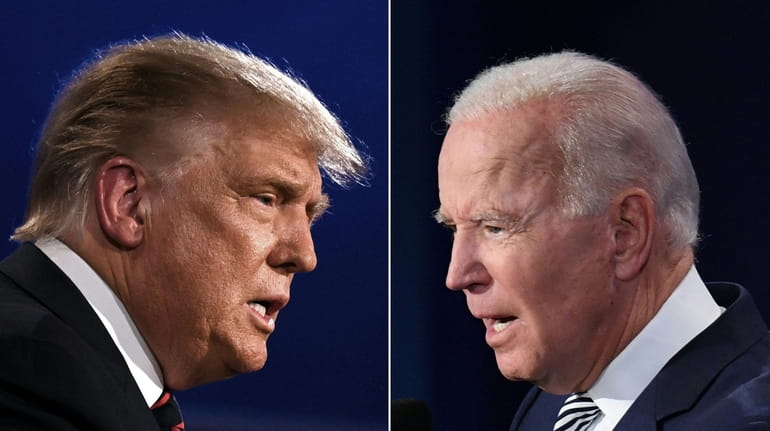The role of religion in presidential elections

This combination of file pictures created on September 29, 2020 shows President Donald Trump and Democratic Presidential candidate former Vice President Joe Biden squaring off during the first presidential debate at the Case Western Reserve University and Cleveland Clinic in Cleveland, Ohio. Credit: AFP via Getty Images/JIM WATSON
Although attention in the presidential campaign now focuses on COVID-19, the economy, the Supreme Court and health care, it is important not to lose sight of the critical role that the faith factor will play in the election outcome. Indeed, after downplaying the role of religion in the 2016 campaign, observers were stunned when GOP nominee Donald Trump pulled off a narrow Electoral College victory with critical help from white evangelical and Catholic voters.
In a narrow election victory, it is possible to attribute the outcome to any one of a number of key voting groups. But consider Trump’s unexpected wins in three Great Lakes states — Michigan, Pennsylvania and Wisconsin — were by a mere 80,000 votes combined. His improved showing among white evangelicals and Catholics over Mitt Romney’s 2012 numbers in those states was more than the margin of victory in 2016.
Trump’s showing among evangelicals was a very big post-election story in 2016. His impressive support from white Catholics did not get so much attention, but was key as well. Going back to the early 1980s until the 2016 election, the national Catholic vote tracked very closely with the overall national popular vote outcome. 2016 is an outlier in that Hillary Rodham Clinton won the popular vote, but Trump won a slight majority of Catholics. This year, Democratic nominee Joe Biden is counting on his Catholic identity to reverse the 2016 outcome among Catholic voters.
How can we then make sense of the religion factor in the 2020 election? First, consider the following voting breakdowns in the voting populations among the one-party-leaning groups:
White evangelical Protestants comprise about one-fifth of the U.S. population and vote overwhelmingly Republican: 81% for Donald Trump (2016), 79% for Mitt Romney (2012), 72% for John McCain (2008), 78% for George W. Bush (2004). Trump is holding very strong support with this group, although with some minor but potentially important slippage from his showing in 2016 with these voters.
Unaffiliated, or the religious "nones," are also about one-fifth of the population and are almost as solidly pro-Democratic as evangelical Protestants are pro-Republican.
Black Protestants — just under 10% of the population — are overwhelmingly pro-Democratic, and surveys have this group giving over 90% support for the Biden-Harris ticket.
Small religious minorities — several percent of the population — mostly are pro-Democratic; these would include Muslims, Jews and a number of Eastern and New Age religious identities. Mormons are the exception as a solidly Republican voting religious group.
Second, other groups divide their support between the major parties to varying degrees:
Mainline Protestants are slightly less than one-fifth of the population and the key determinant for this group is religious practice, not identity. The less religiously observant splits its vote nearly evenly between the major parties in presidential elections, whereas the regular church-attending favor GOP nominees.
Catholics comprise slightly more than one-fifth of the population and are known as the "swing vote" in national elections. White Catholics lean Republican, while Latino Catholics are heavily Democratic; and observant Catholics are heavily Republican, whereas nominal Catholics lean Democratic.
In a closely contested election, the turnout of any of the above groups is potentially critical. For example, surges in white evangelical voting in 2016 and 2004 played key roles in the elections of the GOP nominees. In 2008 and 2012, Barack Obama won the traditional Democratic-leaning religions and unaffiliated voters as well as the Catholic swing vote.
What is the path to victory in 2020?
For Trump, it is a large turnout and commanding majorities among white evangelicals and observant Catholics, a strong majority of observant mainline Protestants, and holding down his losses — or at least hoping for a tepid turnout — in the other groups.
For Biden, it is to hold the same coalition of groups that the Obama-Biden ticket previously carried — Black Protestants, less observant white mainline Protestants, less observant Catholics, the religiously unaffiliated and many small religious minorities — while holding down his losses among white evangelicals and observant Catholics.
Biden and Trump themselves may not say much directly about religion in this election, but their campaigns surely will be working hard to court key religious blocks, as all recognize the powerfully important role that faith plays in presidential elections.
Mark J. Rozell is dean of the Schar School of Policy and Government at George Mason University. This piece was written for The Hartford Courant.
